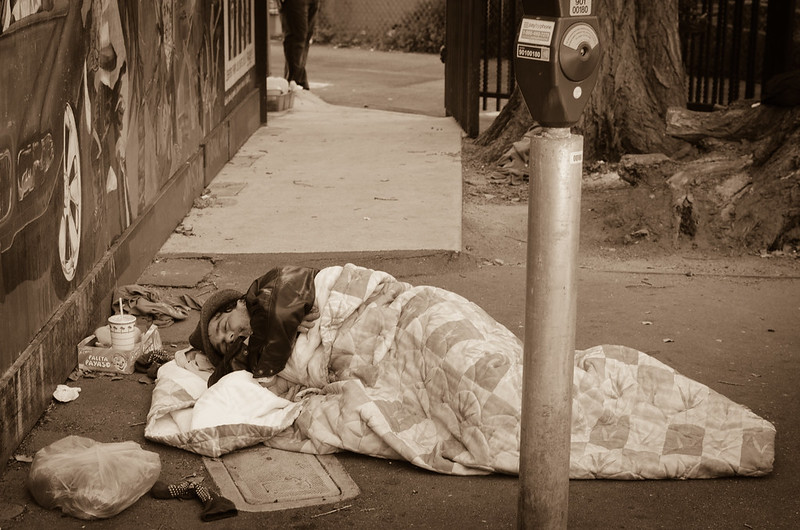By Emma Smith.
On September 20, 2023, a Maricopa County Superior Court judge issued a final judgment in Brown v. City of Phoenix, holding that a Phoenix homeless encampment—known as The Zone—was a public nuisance. This ruling imposed a duty upon the City of Phoenix to remove the tents, makeshift housing structures, and inhabitants from the area.
On its face, this ruling forces the City of Phoenix to “clean up” the streets of downtown—or at least the sidewalks bordered by 9th Avenue, Jackson Street, 13th Avenue and Jefferson Street—providing a “win” for the Zone’s business owners, residents, and others who work in the area. And it ideally prompts the City of Phoenix to take a more active role in addressing the housing crisis and the complex needs of those experiencing homelessness. But this ruling is a misguided attempt to address The Zone and Arizona’s growing homelessness crisis. It sets a dangerous precedent—that cities have already chosen to act on—as it blatantly ignores evidence backed by public health.
A Brief History of Arizona’s Homelessness Crisis and The Zone
Arizona has a housing problem—and it’s only getting worse. The total number of unhoused individuals in the valley has skyrocketed between 2020 and 2023. Between 2020 and 2022, Arizona saw a 23% increase in its unhoused population, bringing the total number of unhoused individuals to over 13,000. And despite increased measures to combat these unprecedented numbers, this number has continued to climb, surging to 14,237 people in 2023. Yet the percentage of people suffering from homelessness on a national level remained stagnant, increasing by less than 1% during this same time period. But why are Arizonans more likely to experience homelessness than residents of other states?
For starters, restrictive zoning regulations limit multifamily housing and lower-cost housing options, resulting in an increase in prices and a lack of affordable housing. From August 2017 to August 2023, rental prices increased by 53% and the average home cost increased by 73% across Arizona. And to keep up with this inflation in housing prices, a family would have to earn $99,500 per year, a number that is out of reach for most Valley residents and Americans alike.
Housing Choice Vouchers offer little support to valley residents in attaining the requisite amount of income needed to find stable housing because vouchers take several years to secure or do not provide enough financial support. On top of this, shelters in the Valley are full nearly every night. And even if there are open beds, shelters may impose stringent conditions on individuals seeking access, such as prohibiting individuals from drug or alcohol use, individuals convicted of felonies, or pet owners—an approach that adversely affects homelessness: People who cannot or will not comply with these conditions simply end up back on the streets or in encampments such as The Zone.
Brown v. City of Phoenix
Property owners, residents, and business owners in The Zone sued the City of Phoenix in the Maricopa County Superior Court for failing to abate a public nuisance. The plaintiffs argued that the urban homeless encampment violated numerous criminal and quality-of-life laws, which the City refused to enforce, thereby maintaining a public nuisance. The court agreed and issued a final judgment in the matter, holding that the City has an obligation to all Zone residents, including the unhoused, to maintain the area known as The Zone.
In its opinion, the court focused on the notion that many unhoused individuals are voluntarily homeless. Certain individuals may not lack access to adequate temporary shelter but choose not to go to a shelter due to wanting to keep their personal belongings, to live with their partners or pets, or addiction.
The court also reasoned that a “Housing First” model is a “soft approach” to homelessness. Housing First is an approach that connects unhoused individuals to permanent housing, with no strings attached. The court found that this lack of strings does not aid those with mental health or substance abuse issues and perpetuates criminal activity due to a lack of enforcement mechanisms. However, this finding ignores research that shows people are better able to address their individual needs when their basic needs, like housing, are met.
What Are the Issues with This Ruling?
As advocates for the unhoused have pointed out, the outcome in Brown simply changes the problem’s appearance; it does not provide a solution.
Homelessness is a public health issue. It—like poverty and employment—is a social determinant of health, meaning that it influences the conditions that shape one’s daily life such as drug usage and felony convictions. In other words, by prohibiting unhoused drug users or felons from accessing shelter and housing resources, these laws drive them back to the issue preventing them from access. For example, unhoused individuals are likely to resort to criminal activities in hopes of being arrested or referred to hospital treatment as a means of having a roof over their heads and food in their stomachs. This results in a continuous cycle between jails, courts, streets, hospitals, and shelters.
The court in Brown, however, rejected this cycle as a “broad, unsupported inference” and instead chose to label homelessness as “voluntary” and the unhoused as “service resistant.” These labels place the fault on the unhoused to fix their situation rather than the bureaucratic system that got them there. This allowed the court in Brown to undermine an unhoused person’s individual needs by simply noting that the unhoused are not worthy of society’s time. Indeed, research suggests that Housing First programs, which take into account an unhoused person’s individual needs, such as pet ownership, are more effective in addressing homelessness than the enforcement-focused strategy the court presented in Brown.
The enforcement-focused strategy that the court embraces in its opinion simply criminalizes homelessness and exacerbates its reach. Enforcement-focused strategies center on the notion that punishment through legal mechanisms like arrests and fines both deters bad behavior and motivates good behavior. However, public camping, loitering, and drunk and disorderly conduct laws that result in citations and arrests only serve to keep the homeless down. Enforcing fines and civil punishment make it challenging for unhoused individuals to save money and exit homelessness. And, because many shelters and government programs do not provide people with criminal records access to their services, criminal punishments may make it more difficult to find housing and work upon release, and qualify for public assistance.
What’s Next?
The court’s holding in Brown has inspired a series of lawsuits in other cities like Salt Lake City, Sacramento, and Tucson, increasing concern regarding the reach of Brown’s non-evidence-based precedent. If the courts in these cities choose to adopt the reasoning presented in Brown, it is likely that rates of homelessness will only increase, and the “wins” that these suits present to the plaintiffs will be short-lived. Regardless of the outcome, it is important to highlight that the law alone is not equipped to address homelessness—the Arizona judiciary’s decision in Brown is only one example of that. It is, therefore, imperative that voters, lawmakers, and judges alike push for public health and evidence based solutions when it comes to America’s homeless crisis.


Emma Smith is a 2L Staff Writer from Springfield, IL. Before attending law school, she studied bioethics at Illinois State University. In her free time, Emma enjoys Pilates, hiking, and spending time with friends.
